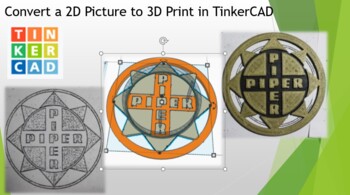Convert a 2D Picture to 3D Print in TinkerCAD
3D-PT
125 Followers
Grade Levels
9th - 12th, Higher Education, Adult Education, Homeschool, Staff
Subjects
Resource Type
Standards
CCSSHSN-VM.A.1
CCSSHSN-VM.A.2
CCSSHSN-VM.B.4
CCSSHSN-VM.B.4a
CCSSHSN-VM.B.4b
Formats Included
- PDF
- Easel Activity
Pages
3 pages
3D-PT
125 Followers
Easel Activity Included
This resource includes a ready-to-use interactive activity students can complete on any device. Easel by TPT is free to use! Learn more.
Also included in
- Empower your students with the fascinating world of 3D printing through our comprehensive "TinkerCAD 3D Printing Lesson Bundle." This resource is your all-in-one solution for introducing 3D design, creativity, and innovation into your classroom.Key Highlights: Comprehensive Curriculum: Our bundle ofPrice $113.54Original Price $162.20Save $48.66
Description
If you are new to 3D printing, or want to bring a new skill into TinkerCAD, this activity is a great resource.
It's possible to take a 2D drawing and convert it into a 3D print using free & easy to use software tools. You don't need extensive graphics programs with steep learning curves to edit and prepare the pictures for 3D printing.
A FREE video on how to do this can be found HERE
You can use this to make stamps, cookie cutters, signs, trivets, or other items from a drawing! This is a fun activity that can fill up those weird half days, or can be used to expand other units.
Total Pages
3 pages
Answer Key
N/A
Teaching Duration
90 minutes
Report this resource to TPT
Reported resources will be reviewed by our team. Report this resource to let us know if this resource violates TPT’s content guidelines.
Standards
to see state-specific standards (only available in the US).
CCSSHSN-VM.A.1
Recognize vector quantities as having both magnitude and direction. Represent vector quantities by directed line segments, and use appropriate symbols for vectors and their magnitudes (e.g., 𝙫, |𝙫|, ||𝙫||, 𝘷).
CCSSHSN-VM.A.2
Find the components of a vector by subtracting the coordinates of an initial point from the coordinates of a terminal point.
CCSSHSN-VM.B.4
Add and subtract vectors.
CCSSHSN-VM.B.4a
Add vectors end-to-end, component-wise, and by the parallelogram rule. Understand that the magnitude of a sum of two vectors is typically not the sum of the magnitudes.
CCSSHSN-VM.B.4b
Given two vectors in magnitude and direction form, determine the magnitude and direction of their sum.






